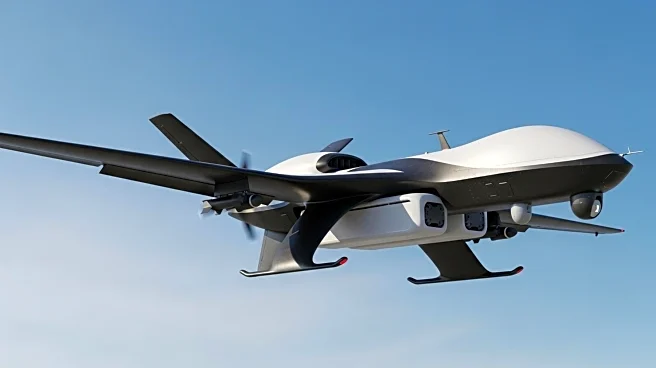What's Happening?
Pyka has introduced a new unmanned aerial vehicle (UAV) named DropShip, designed for military logistics missions, including parachute cargo drops. Known for its autonomous crop-dusting aircraft, Pyka's DropShip features a combination of electric-driven and diesel engine-powered propellers, offering a ferry range of 3,500 miles or a 1,000-mile range with a 400-pound payload. The UAV can drop payloads from its cargo bay, parachuting to within 150 feet of its target. It supports theater-scale operations and tactical resupply, capable of flying in all-electric mode for covert missions. The DropShip is designed with a modular mission system for carrying intelligence, surveillance, and reconnaissance sensors, and can serve as an expeditionary power supply. Pyka aims to test flight the UAV in 2026.
Why It's Important?
The introduction of DropShip represents a significant advancement in military logistics and UAV technology. Its ability to operate in contested environments and support covert missions could enhance military operations' efficiency and safety. The modular design allows for versatile applications, including humanitarian missions, potentially reducing costs compared to traditional assets. The participation in the U.S. Army Future Command’s Project Convergence and the U.S. Air Force’s AFWERX contract highlights its strategic importance and potential impact on military logistics and communications.
What's Next?
Pyka plans to conduct test flights for the DropShip in 2026, which will be crucial for assessing its operational capabilities and reliability. The UAV's involvement in military exercises and contracts suggests further development and potential adoption by military forces. Stakeholders, including military leaders and defense contractors, will likely monitor its performance closely, considering its implications for future logistics and reconnaissance operations.
Beyond the Headlines
The DropShip's development raises questions about the ethical use of UAVs in military and humanitarian contexts. Its ability to operate autonomously and in covert modes could lead to discussions on regulations and oversight in UAV deployment. Additionally, the technology's dual-use nature for military and humanitarian purposes may influence future policy decisions regarding UAV applications.












